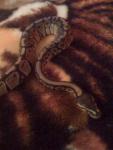» Site Navigation

2 members and 635 guests
Most users ever online was 47,180, 07-16-2025 at 05:30 PM.
» Today's Birthdays

» Stats

Members: 75,909
Threads: 249,108
Posts: 2,572,142
Top Poster: JLC (31,651)
|
-
Registered User


Re: largest colubrid species?
 Originally Posted by CoolioTiffany

Umm.. maybe Indigos? (I think that's what they are called..)
They seem to be kinda heavy-looking. Not meaning fat, but heavily scaled.
You are right there tiff. Its called the Indigo Snake.
The Eastern Indigo Snake is the largest non-venomous snake in North America. The indigo is yet another herp species that illustrates the severity of the problems faced by numerous reptiles and amphibians. Of the six threats to the herpetofauna outlined by Partners in Amphibian and Reptile Conservation (PARC), populations of the indigo snake have been dramatically affected by two threats: habitat loss and unsustainable use. Population declines have been so substantial that the U.S. Fish and Wildlife Service listed indigo snakes as a "threatened species" in 1979—for a snake species to be federally listed, the problem has to be bad, as snakes are not typically high on the list of people’s favorite animals. Indigo snakes are protected at the state level in Alabama, and have full protection as a threatened species in Florida and Georgia, and as an endangered species in South Carolina and Mississippi.
EDIT!!!!
The indigo snake, a member of the colubrid family of snakes, is the (unofficially) longest snake in North America, with the longest recorded specimen measuring 9.2 feet (2.8m), but it is not the longest of its genus. The yellowtail cribo, also of the genus Drymarchon, has been known to reach 10 feet (3.05m) in length, but it is located in Central and South America and is dwarfed by the anaconda, the largest (longest and heaviest) known snake in the Americas. The eastern diamondback rattlesnake gets much heavier than the indigo but is not as long. The indigo snake gets its name from the glossy iridescent blackish-purple sheen it displays in bright light.
It is carnivorous, like all snakes, and will eat any other small animal it can overpower. It has been known to kill its prey by wildly beating it against nearby objects. Captive specimen are frequently fed dead prey to prevent injury to the snake from this violent method of subduing its prey. Its diet has been known to include other snakes (ophiophagy), including venomous ones, as it is immune to the venom of the North American rattlesnakes. It often will cohabit with gopher tortoises in their underground burrows, although it will settle for armadillo holes, hollow logs, and debris piles when gopher tortoise burrows can't be found. Hunters, hoping to flush out rattlesnakes, often wind up accidentally killing indigo snakes when they illegally pour gasoline into the burrows of gopher tortoises (a practice referred to as "gassing"), even though the tortoises themselves are also endangered and protected.
 xXxFluffyxXx 
Aim=ask me
Msn & Yahoo =ask me
1.0 100% Het Pied
0.1 50% Het Pied
0.3 Normals
0.0.3 Beardie
-
The Following User Says Thank You to xXxFluffyEmoxXx For This Useful Post:
 Posting Permissions
Posting Permissions
- You may not post new threads
- You may not post replies
- You may not post attachments
- You may not edit your posts
-
Forum Rules
|










 xXxFluffyxXx
xXxFluffyxXx
 Reply With Quote
Reply With Quote